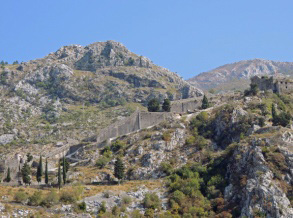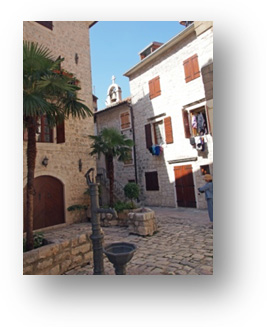 
VENICE | CROATIA | MONTENEGRO | CORFU | KAFALONIA | PYLOS | NAFPLION | PIRAEUS | MILOS | MYKONOS PATMOS | KUSADASI | CHIOS | ISTANBUL DAY 1 | ISTANBUL DAY 2 | ISTANBUL DAY 3 | TRAVEL REFLECTIONS |
 
VENICE | CROATIA | MONTENEGRO | CORFU | KAFALONIA | PYLOS | NAFPLION | PIRAEUS | MILOS | MYKONOS PATMOS | KUSADASI | CHIOS | ISTANBUL DAY 1 | ISTANBUL DAY 2 | ISTANBUL DAY 3 | TRAVEL REFLECTIONS |
MONTENEGRO: Kotor, St. Stefan and Budva, 9-24-12
Here's how Kotor, Monetnegro is described in the on-board newsletter: Picturesque Kotor with its walled town nestling at the head of southern Europe's deepest fjord has Montenegro's most dramatic setting. The Old Town of Kotor lies in the shadow of the fearsome St. John's Hill. The walls protecting this town are a fortification masterpiece built skyward into the steep and irregular slopes of the mountain looming above it. (The wall reminded CC and me of steep parts of the Great Wall and, from a distance, there's an interesting resemblance between the two.) Last night two other couples and we had dinner at the cruise's equivilant of the captain's table. Traveling with hundreds of people we don't know and likely would never meet under any other conditions makes communal tables a conversational crap shoot. However, last night was unexpectedly fun and lively. The travelers at this table, and of course the captain, were all seasoned travelers and had enough interesing adventures to make the evening go by quickly. This morning, we arrived at our docking point in Kotor about 7 a.m after going through the deep fjord I described. Today, instead of a private tour we decided to do the On that point. The whole of the Montenegran Riveria is a picture postcard, with weather during the season that is reminiscent of Solana Beach at its best. The houses are quaint stucco structures with tile roofs clustered together like one might create a toy train village. The Adriatic Sea here is clear, blue and inviting. From a distance, each village appears to be a carbon copy of the last. Hard to find anything not to like. According to our guide, Russians have discovered Montenegro and driven property prices through the roof. After St. Stefan we drove to the town of Budva. Cities along the seacoast that have existed for hundreds of years and have survived until today are typically walled (the Venetians and the Turks were particularly pesky). The inhabitants gathered behind these walls for protection. The cities contain one or more squares, one or more churches of various denominations and are built of stone (including the walkways). Budva follows this model, well preserved with a walkable wall that still surrounds the center city and overlooks the harbor. As with most of these walled cities, although people still live behind the walls, when the potential of invaders diminished, the cities expanded outside the walls.  
We returned from the tour and walked around Kotor, still another walled city. What makes this city really unique is that massive and tall protection walls climb the hillside behind the city. As I said earlier, they are quite large and even from a distance and reminded us of the Great Wall. The sail out of the fjord today at 4 p.m. was as good as anything we saw all day.
|